Circulation and Transport Processes during an Extreme Freshwater Discharge Event at the Tagus Estuary
Abstract
1. Introduction
2. Study Area
3. Materials and Methods
3.1. Data
3.2. Numerical Model
3.2.1. Model Implementation
3.2.2. Model Validation
3.3. Model Scenarios
4. Results
4.1. Event Characterization: 2013
4.2. Changes in Water Properties Transport under a Climate Change Context
5. Discussion
6. Conclusions
Author Contributions
Funding
Institutional Review Board Statement
Informed Consent Statement
Data Availability Statement
Conflicts of Interest
References
- Chapman, P.M. Management of coastal lagoons under climate change. Estuar. Coast. Shelf Sci. 2012, 110, 32–35. [Google Scholar] [CrossRef]
- Statham, P.J. Nutrients in estuaries—An overview and the potential impacts of climate change. Sci. Total Environ. 2012, 434, 213–227. [Google Scholar] [CrossRef] [PubMed]
- Rodrigues, M.; Rosa, A.; Cravo, A.; Jacob, J.; Fortunato, A.B. Effects of climate change and anthropogenic pressures in the water quality of a coastal lagoon (Ria Formosa, Portugal). Sci. Total Environ. 2021, 780, 146311. [Google Scholar] [CrossRef] [PubMed]
- IPCC. Climate Change 2013: The Physical Science Basis. Contribution of Working Group I to the Fifth Assessment Report of the Intergovernmental Panel on Climate Change; Cambridge University Press: Cambridge, UK; New York, NY, USA, 2013.
- Rodrigues, M.; Oliveira, A.; Queiroga, H.; Brotas, V.; Fortunato, A.B. Modelling the effects of climate change in estuarine ecosystems with coupled hydrodynamic and biogeochemical models. In Developments in Environmental Modelling; Elsevier: Amsterdam, The Netherlands, 2015; Volume 27, pp. 271–288. [Google Scholar]
- Ferrero, B.; Tonelli, M.; Marcello, F.; Wainer, I. Long-term Regional Dynamic Sea Level Changes from CMIP6 Projections. Adv. Atmos. Sci. 2021, 38, 157–167. [Google Scholar] [CrossRef]
- IPCC. Climate Change 2021: The Physical Science Basis. Contribution of Working Group I to the Sixth Assessment Report of the Intergovernmental Panel on Climate Change; Cambridge University Press: Cambridge, UK; New York, NY, USA, 2021.
- De Pascalis, F.; Pérez-Ruzafa, A.; Gilabert, J.; Marcos, C.; Umgiesser, G. Climate change response of the Mar Menor coastal lagoon (Spain) using a hydrodynamic finite element model. Estuar. Coast. Shelf Sci. 2012, 114, 118–129. [Google Scholar] [CrossRef]
- Shalby, A.; Elshemy, M.; Zeidan, B.A. Modeling of climate change impacts on Lake Burullus, coastal lagoon (Egypt). Int. J. Sediment Res. 2021, 36, 756–769. [Google Scholar] [CrossRef]
- Brito, A.C.; Newton, A.; Tett, P.; Fernandes, T.F. How will shallow coastal lagoons respond to climate change? A modelling investigation. Estuar. Coast. Shelf Sci. 2012, 112, 98–104. [Google Scholar] [CrossRef]
- Lloret, J.; Marín, A.; Marín-Guirao, L. Is coastal lagoon eutrophication likely to be aggravated by global climate change? Estuar. Coast. Shelf Sci. 2008, 78, 403–412. [Google Scholar] [CrossRef]
- Pesce, M.; Critto, A.; Torresan, S.; Giubilato, E.; Pizzol, L.; Marcomini, A. Assessing uncertainty of hydrological and ecological parameters originating from the application of an ensemble of ten global-regional climate model projections in a coastal ecosystem of the lagoon of Venice, Italy. Ecol. Eng. 2019, 133, 121–136. [Google Scholar] [CrossRef]
- Vaz, N.; Rodrigues, J.G.; Mateus, M.; Franz, G.; Campuzano, F.; Neves, R.; Dias, J.M. Subtidal variability of the Tagus river plume in winter 2013. Sci. Total Environ. 2018, 627, 1353–1362. [Google Scholar] [CrossRef]
- Rodrigues, J. The Tagus Estuarine Plume Variability: Impact in Coastal Circulation and Hydrography. Master’s Thesis, University of Aveiro, Aveiro, Portugal, 2015. [Google Scholar]
- Des, M. Hydrodynamics of NW Iberian Peninsula under Past and Future Climate Hydrodynamics of NW Iberian Peninsula under Past and Future Climate Conditions Marisela Des Villanueva Mención Internacional. Ph.D. Thesis, Universidade de Vigo, Vigo, Spain, 2020. [Google Scholar]
- de Pablo, H.; Sobrinho, J.; Garcia, M.; Campuzano, F.; Juliano, M.; Neves, R. Validation of the 3D-MOHID hydrodynamic model for the Tagus coastal area. Water 2019, 11, 1713. [Google Scholar] [CrossRef]
- Vaz, N.; Mateus, M.; Pinto, L.; Neves, R.; Dias, J.M. The Tagus Estuary as a Numerical Modeling Test Bed: A Review. Geosciences 2020, 10, 4. [Google Scholar] [CrossRef]
- Vaz, N.; Dias, J.M. Hydrographic characterization of an estuarine tidal channel. J. Mar. Syst. 2008, 70, 168–181. [Google Scholar] [CrossRef]
- Franz, G.; Pinto, L.; Ascione, I.; Mateus, M.; Fernandes, R.; Leitão, P.; Neves, R. Modelling of cohesive sediment dynamics in tidal estuarine systems: Case study of Tagus estuary, Portugal. Estuar. Coast. Shelf Sci. 2014, 151, 34–44. [Google Scholar] [CrossRef]
- Portela, L.I.; Neves, R. Numerical modelling of suspended sediment transport in tidal estuaries: A comparison between the Tagus (Portugal) and the Scheldt (Belgium-The Netherlands). Netherl. J. Aquat. Ecol. 1994, 28, 329–335. [Google Scholar] [CrossRef]
- Lobanova, A.; Koch, H.; Liersch, S.; Hattermann, F.F.; Krysanova, V. Impacts of changing climate on the hydrology and hydropower production of the Tagus River basin. Hydrol. Process. 2016, 30, 5039–5052. [Google Scholar] [CrossRef]
- Rodrigues, R.; Cunha, R.; Rocha, F. Evaluation of river inflows to the Portuguese estuaries based on their duration curves. EMMA Proj. Rep. 2009, 40. [Google Scholar]
- Pinto, P.J.; Kondolf, G.M. Evolution of two urbanized estuaries: Environmental change, legal framework, and implications for sea-level rise vulnerability. Water 2016, 8, 535. [Google Scholar] [CrossRef]
- Guerreiro, M.; Fortunato, A.B.; Freire, P.; Rilo, A.; Taborda, R.; Freitas, M.C.; Andrade, C.; Silva, T.; Rodrigues, M.; Bertin, X.; et al. Evolution of the hydrodynamics of the Tagus estuary (Portugal) in the 21st century. J. Integr. Coast. Zo. Manag. 2015, 15, 65–80. [Google Scholar] [CrossRef]
- Fortunato, A.B.; Baptista, A.M.; Luettich Jr, R.A. A three-dimensional model of tidal currents in the mouth of the Tagus estuary. Cont. Shelf Res. 1997, 17, 1689–1714. [Google Scholar] [CrossRef]
- Fortunato, A.B.; Oliveira, A.; Baptista, A.M. On the effect of tidal flats on the hydrodynamics of the Tagus estuary. Oceanol. Acta 1999, 22, 31–44. [Google Scholar] [CrossRef]
- Rodrigues, M.; Fortunato, A.B. Assessment of a three-dimensional baroclinic circulation model of the Tagus estuary (Portugal). AIMS Environ. Sci. 2017, 4, 763–787. [Google Scholar] [CrossRef]
- Neves, F.S. Dynamics and Hydrology of the Tagus Estuary: Results from In Situ Observations. Ph.D. Thesis, University of Lisbon, Lisbon, Portugal, 2010. [Google Scholar]
- Vaz, N.; Dias, J.M. Residual currents and transport pathways in the Tagus estuary, Portugal: The role of freshwater discharge and wind. J. Coast. Res. 2014, 70, 610–625. [Google Scholar] [CrossRef]
- e Silva, J.D. Controls on Exchange in a Subtropical Tidal Embayment, Maputo Bay. Ph.D. Thesis, University of Wales, Bangor, Wales, 2007. [Google Scholar]
- Matsumoto, K.; Takanezawa, T.; Ooe, M. Ocean tide models developed by assimilating TOPEX/POSEIDON altimeter data into hydrodynamical model: A global model and a regional model around Japan. J. Oceanogr. 2000, 56, 567–581. [Google Scholar] [CrossRef]
- Lúcio, C.M.C. Análise do Comportamento Hidrológico da Bacia Hidrográfica do rio de Loures e Modelação da Sua Susceptibilidade a Cheias. Master’s Thesis, University of Lisbon, Lisbon, Portugal, 2014. [Google Scholar]
- Deltares. Delft3D-FLOW User Manual; Deltares: Delft, The Netherlands, 2021. [Google Scholar]
- Ribeiro, A.S. Coupled Modelling of the Tagus and Sado Estuaries and Their Associated Mesoscale Patterns. Master’s Thesis, University of Aveiro, Aveiro, Portugal, 2015. [Google Scholar]
- Braunschweig, F.; Martins, F.; Chambel, P.; Neves, R. A methodology to estimate renewal time scales in estuaries: The Tagus Estuary case. In Ocean Dynamics; Springer: Berlin, Germany, 2003; Volume 53, pp. 137–145. [Google Scholar]
- Fry, V.A.; Aubrey, D.G. Tidal velocity asymmetries and bedload transport in shallow embayments. Estuar. Coast. Shelf Sci. 1990, 30, 453–473. [Google Scholar] [CrossRef]
- Willmott, C.J. On the validation of models. Phys. Geogr. 1981, 2, 184–194. [Google Scholar] [CrossRef]
- Warner, J.C.; Geyer, W.R.; Lerczak, J.A. Numerical modeling of an estuary: A comprehensive skill assessment. J. Geophys. Res. Ocean. 2005, 110, C05001. [Google Scholar] [CrossRef]
- Dias, J.M.; Valentim, J.M.; Sousa, M.C. A numerical study of local variations in tidal regime of Tagus estuary, Portugal. PLoS ONE 2013, 8, e80540. [Google Scholar] [CrossRef]
- Picado, A.; Mendes, J.; Ruela, R.; Pinheiro, J.; Dias, J.M. Physico-chemical characterization of two portuguese coastal systems: Ria de Alvor and Mira estuary. J. Mar. Sci. Eng. 2020, 8, 537. [Google Scholar] [CrossRef]
- Dias, J.M.; Pereira, F.; Picado, A.; Lopes, C.L.; Pinheiro, J.P.; Lopes, S.M.; Pinho, P.G. A comprehensive estuarine hydrodynamics-salinity study: Impact of morphologic changes on Ria de Aveiro (atlantic coast of Portugal). J. Mar. Sci. Eng. 2021, 9, 234. [Google Scholar] [CrossRef]
- Otero, P.; Ruiz-Villarreal, M.; Peliz, A. Variability of river plumes off Northwest Iberia in response to wind events. J. Mar. Syst. 2008, 72, 238–255. [Google Scholar] [CrossRef]
- Prinsenberg, S.J.; Rattray, M., Jr. Effects of continental slope and variable Brunt-Väisälä frequency on the coastal generation of internal tides. Deep Sea Res. Oceanogr. Abstr. 1975, 22, 251–263. [Google Scholar] [CrossRef]
- Diário de Notícias Subida do rio coloca Bacia do Tejo em “alerta amarelo” 2013. Available online: https://www.dn.pt/portugal/sul/subida-do-rio-coloca-bacia-do-tejo-em-alerta-amarelo-3134341.html (accessed on 1 August 2021).
- Chua, V.P.; Xu, M. Impacts of sea-level rise on estuarine circulation: An idealized estuary and San Francisco Bay. J. Mar. Syst. 2014, 139, 58–67. [Google Scholar] [CrossRef]
- Losada, M.A.; Díez-Minguito, M.; Reyes-Merlo, M.Á. Tidal-fluvial interaction in the Guadalquivir Estuary: Spatial and frequency-dependent response of currents and water levels. J. Geophys. Res. Ocean. 2017, 122, 847–865. [Google Scholar]
- Fortunato, A.B.; Freire, P.; Mengual, B.; Bertin, X.; Pinto, C.; Martins, K.; Guérin, T.; Azevedo, A. Sediment dynamics and morphological evolution in the Tagus Estuary inlet. Mar. Geol. 2021, 440, 106590. [Google Scholar] [CrossRef]
- Mills, L.; Janeiro, J.; Martins, F. The Effects of Sea Level Rise on Salinity and Tidal Flooding Patterns in the Guadiana Estuary. In Proceedings of the International Conference on Sustainable Development of Water and Environment, Incheon, Korea, 13–14 January 2020; pp. 17–30. [Google Scholar]
- Hong, B.; Shen, J. Responses of estuarine salinity and transport processes to potential future sea-level rise in the Chesapeake Bay. Estuar. Coast. Shelf Sci. 2012, 104–105, 33–35. [Google Scholar] [CrossRef]
- Vaz, N.; Fernandes, L.; Leitão, P.C.; Dias, J.M.; Neves, R. The Tagus estuarine plume induced by wind and river runoff: Winter 2007 case study. J. Coast. Res. 2009, 2, 1090–1094. [Google Scholar]
- Vaz, N.; Mateus, M.; Plecha, S.; Sousa, M.C.; Leitão, P.C.; Neves, R.; Dias, J.M. Modeling SST and chlorophyll patterns in a coupled estuary-coastal system of Portugal: The Tagus case study. J. Mar. Syst. 2015, 147, 123–137. [Google Scholar] [CrossRef]
- Vargas, C.I.C.; Vaz, N.; Dias, J.M. An evaluation of climate change effects in estuarine salinity patterns: Application to Ria de Aveiro shallow water system. Estuar. Coast. Shelf Sci. 2017, 189, 33–45. [Google Scholar] [CrossRef]
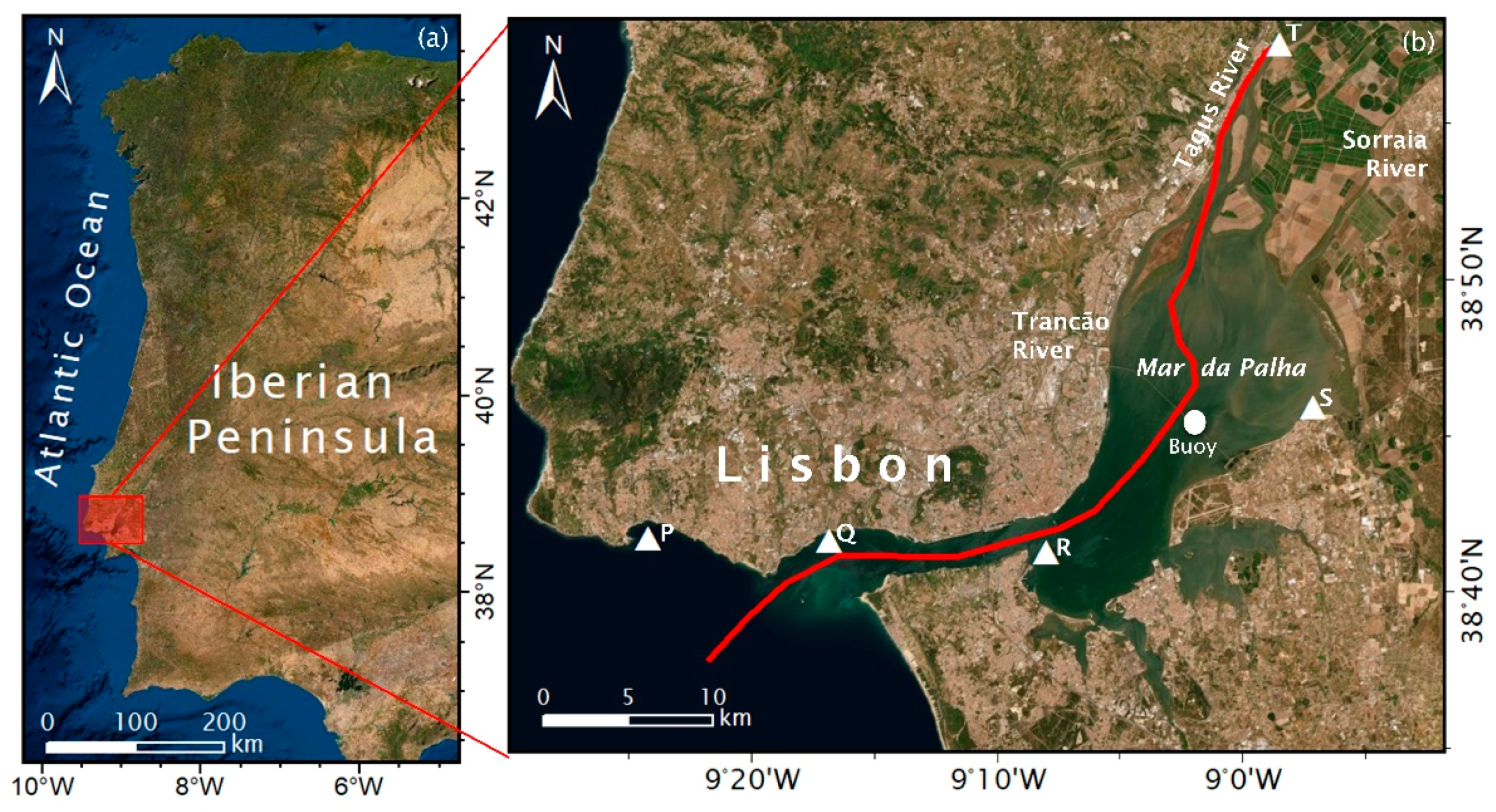


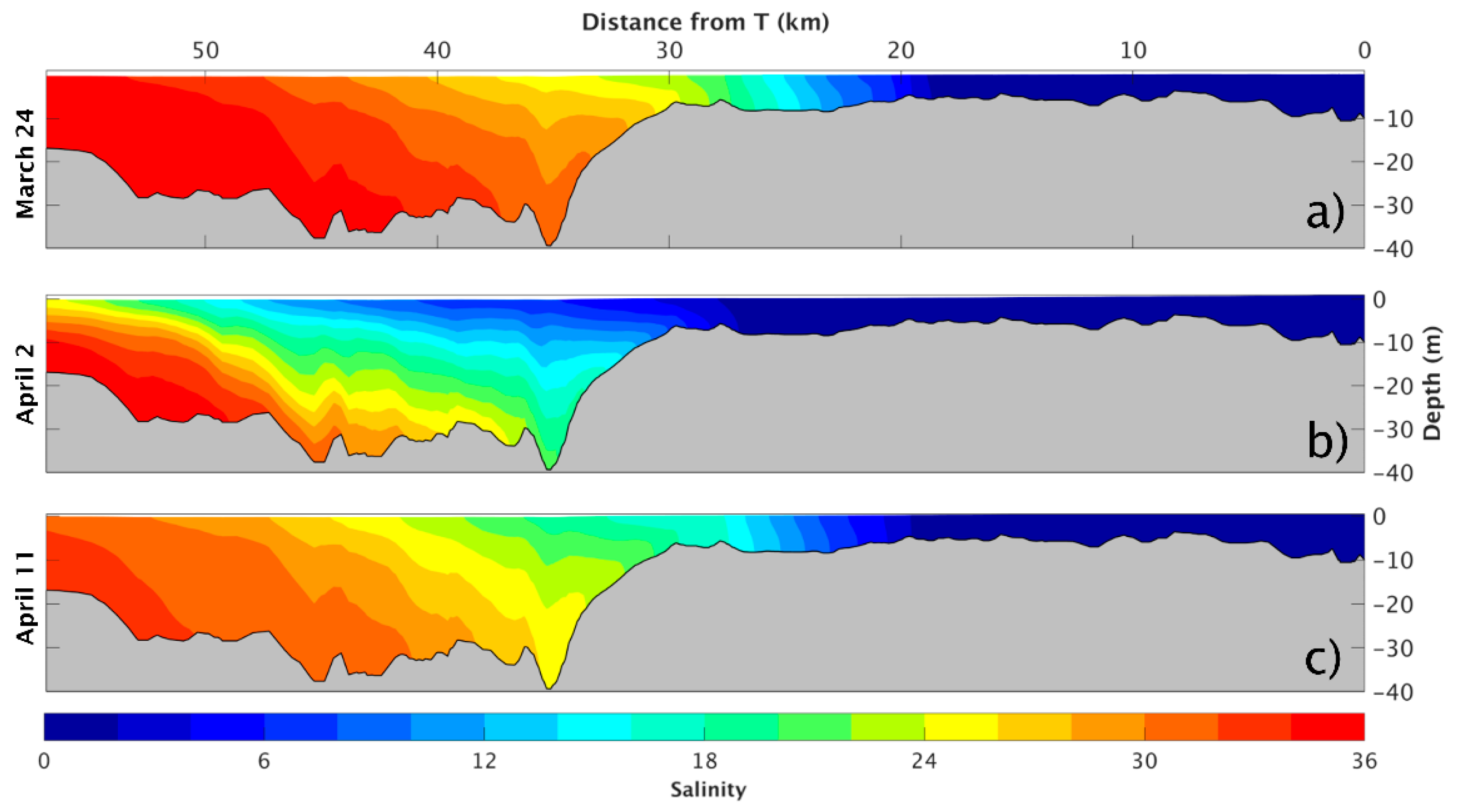
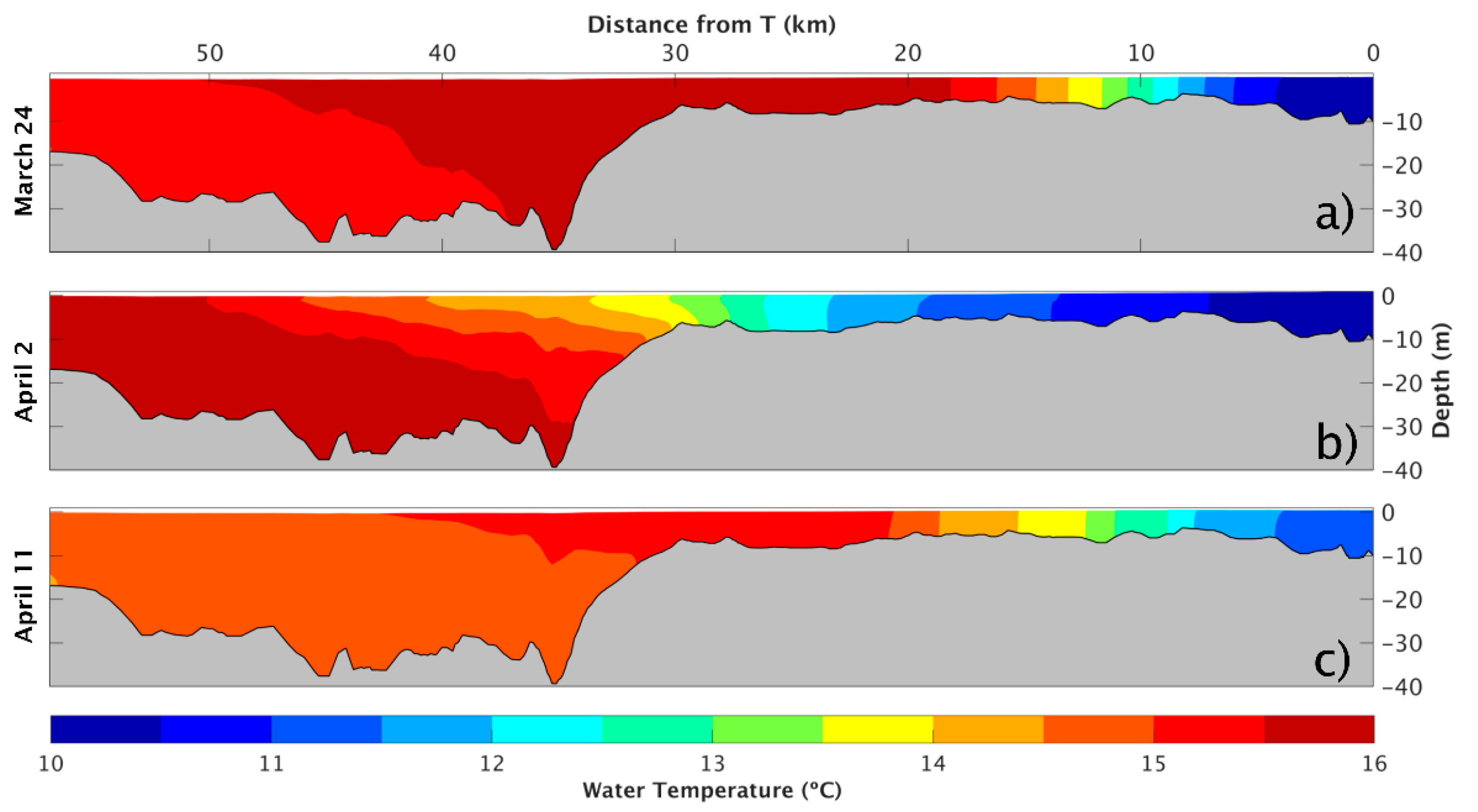
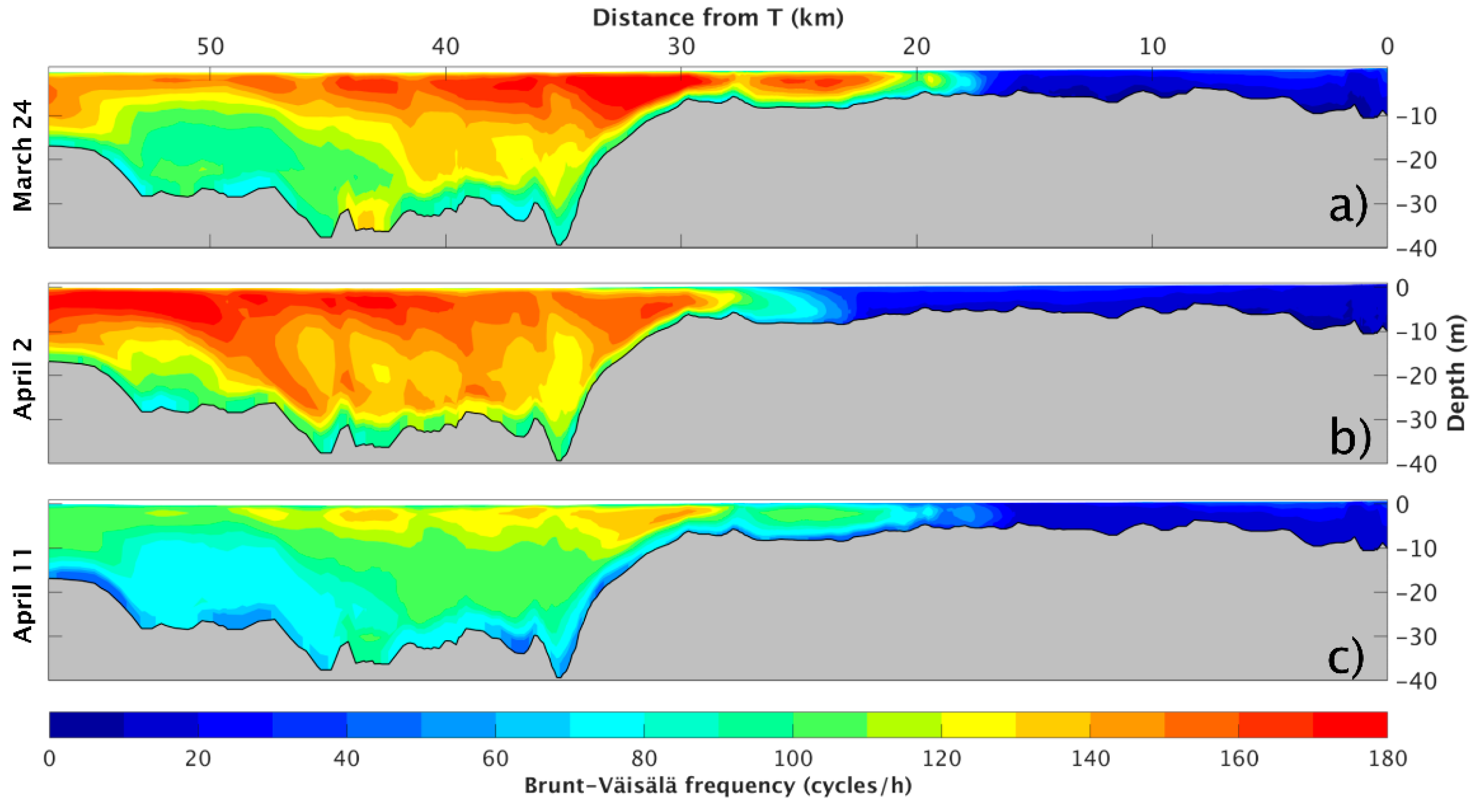
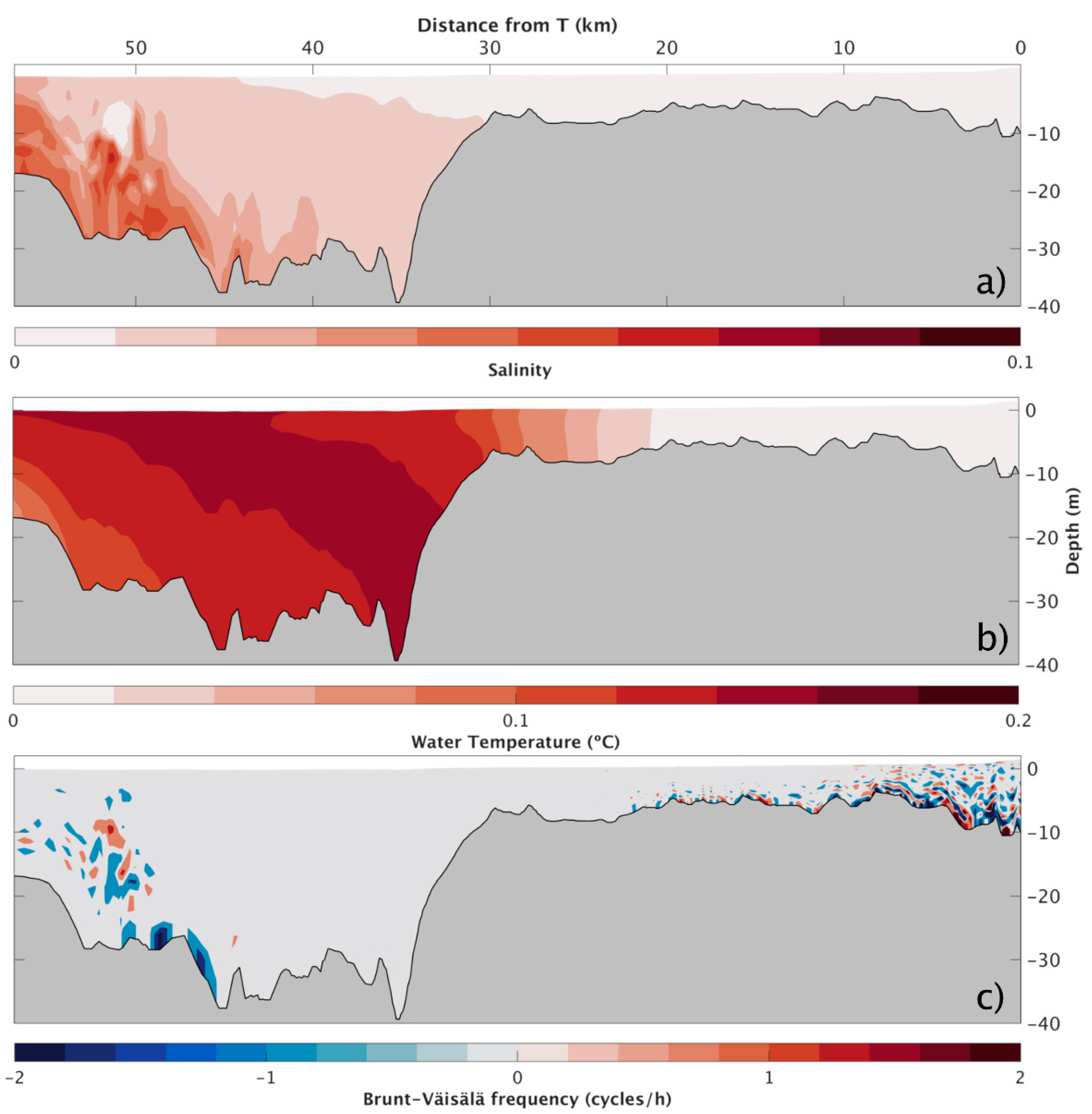
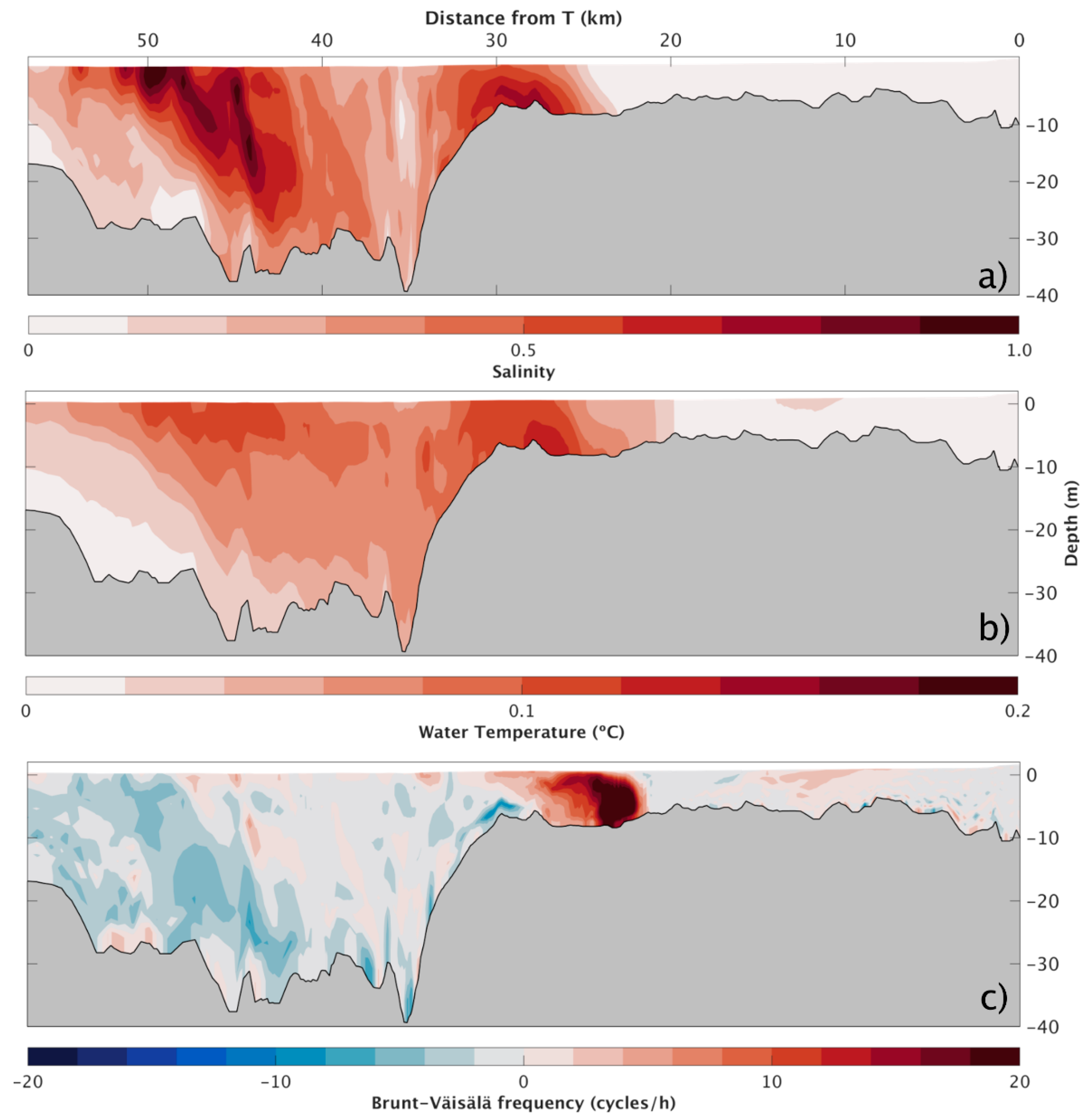
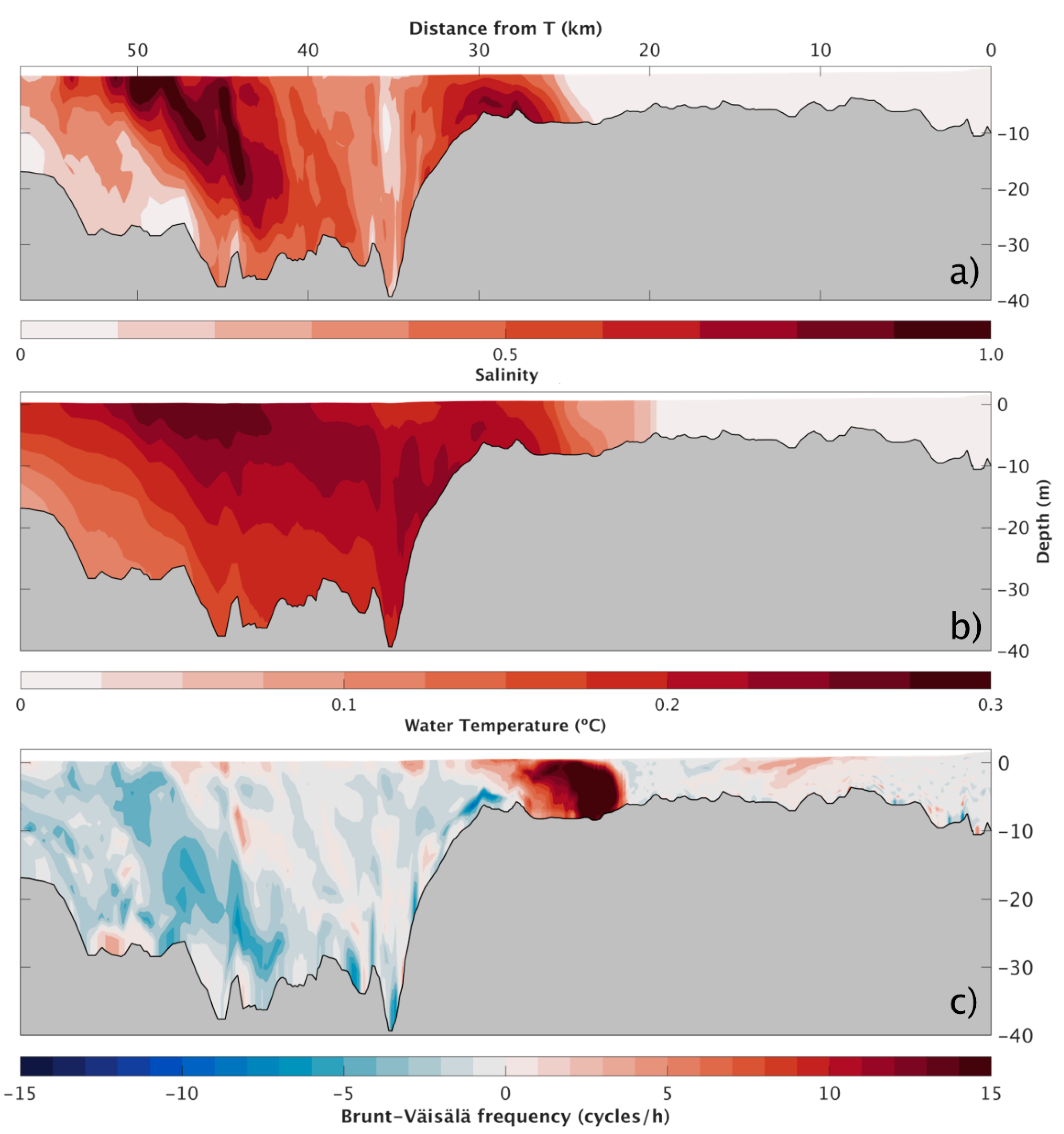
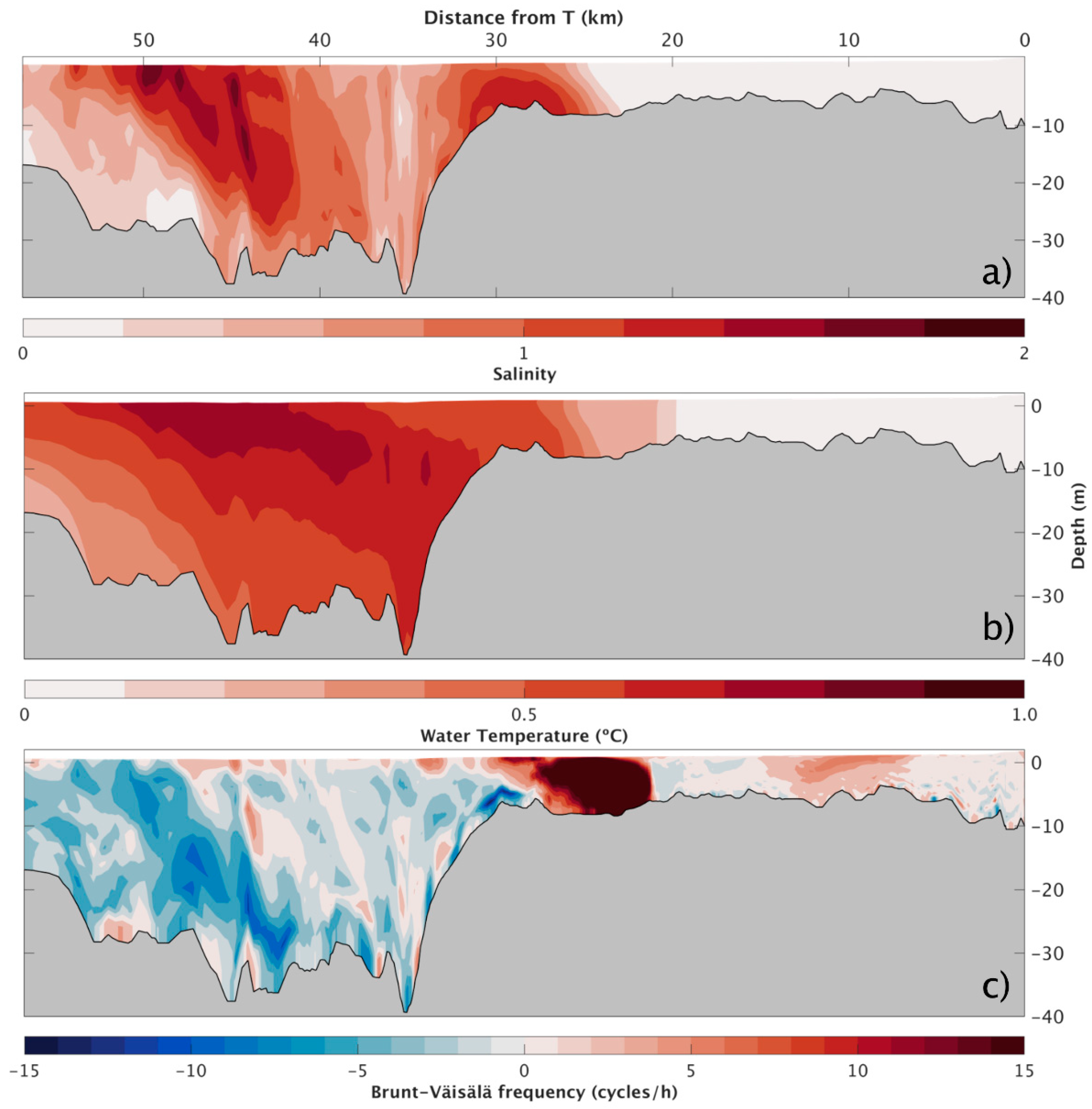
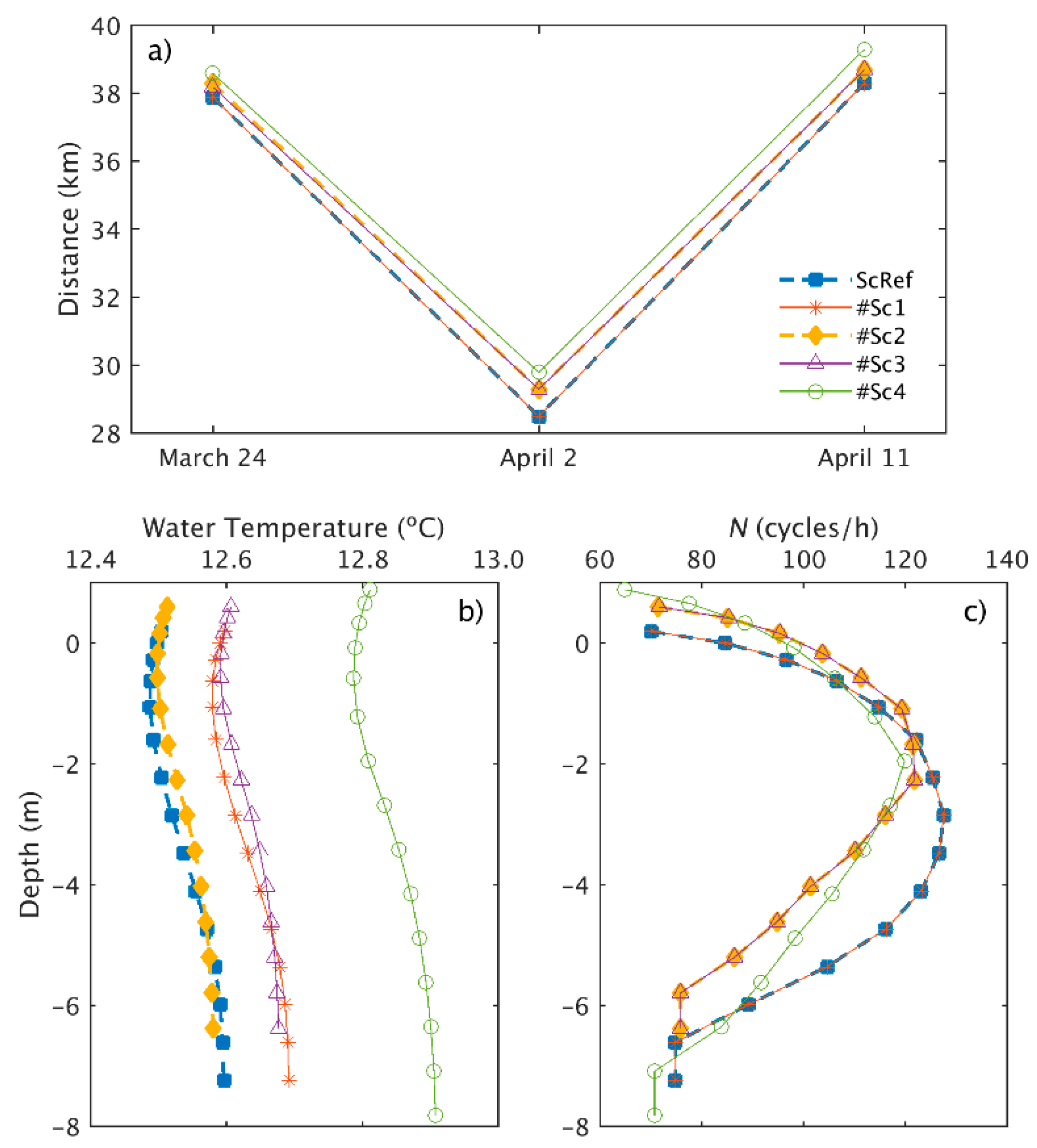
| Parameter | Specification |
|---|---|
| Time Step | 30 s |
| Process | Hydrodynamics, salt, and heat transport |
| Wind | Variable (Era-Interim) |
| Discharge | Variable |
| Boundary Forcing | Harmonic constituents, salinity and water temperature |
| Bottom Roughness | Variable Manning coefficient |
| Background horizontal eddy viscosity and diffusivity | 10 m2/s |
| Background vertical eddy viscosity and diffusivity | 10−5 m2/s |
| Air Temperature | Heat flux model |
| Heat Flux Model | Absolute flux, net solar radiation |
| Threshold depth | 0.1 m |
| Turbulence closure | K—ε |
| Wall slip condition | Free |
| Spin-up period | 2 months |
| Station | RMSE (m) | ∆E (%) | SKILL |
|---|---|---|---|
| Vila Franca de Xira (T) | 0.19 | 6.29 | 0.99 |
| Alcochete (S) | 0.14 | 4.71 | 0.99 |
| Lisboa (R) | 0.10 | 3.31 | 0.99 |
| Paço de Arcos (Q) | 0.42 | 16.04 | 0.92 |
| Cascais (P) | 0.07 | 2.81 | 0.99 |
| Water Temperature (°C) | Salinity | |
|---|---|---|
| RMSE | 0.48 | 1.68 |
| SKILL | 0.77 | 0.61 |
| Scenario | Sea Level Rise (m) | Air Temperature (°C) |
|---|---|---|
| #ScRef | 0 | 0 |
| #Sc1 | 0 | +1.0 |
| #Sc2 | +0.40 | 0 |
| #Sc3 | +0.40 | +1.0 |
| #Sc4 | +0.70 | +4.0 |
Publisher’s Note: MDPI stays neutral with regard to jurisdictional claims in published maps and institutional affiliations. |
© 2022 by the authors. Licensee MDPI, Basel, Switzerland. This article is an open access article distributed under the terms and conditions of the Creative Commons Attribution (CC BY) license (https://creativecommons.org/licenses/by/4.0/).
Share and Cite
Ribeiro, A.F.; Sousa, M.; Picado, A.; Ribeiro, A.S.; Dias, J.M.; Vaz, N. Circulation and Transport Processes during an Extreme Freshwater Discharge Event at the Tagus Estuary. J. Mar. Sci. Eng. 2022, 10, 1410. https://doi.org/10.3390/jmse10101410
Ribeiro AF, Sousa M, Picado A, Ribeiro AS, Dias JM, Vaz N. Circulation and Transport Processes during an Extreme Freshwater Discharge Event at the Tagus Estuary. Journal of Marine Science and Engineering. 2022; 10(10):1410. https://doi.org/10.3390/jmse10101410
Chicago/Turabian StyleRibeiro, Ana Filipa, Magda Sousa, Ana Picado, Américo Soares Ribeiro, João Miguel Dias, and Nuno Vaz. 2022. "Circulation and Transport Processes during an Extreme Freshwater Discharge Event at the Tagus Estuary" Journal of Marine Science and Engineering 10, no. 10: 1410. https://doi.org/10.3390/jmse10101410
APA StyleRibeiro, A. F., Sousa, M., Picado, A., Ribeiro, A. S., Dias, J. M., & Vaz, N. (2022). Circulation and Transport Processes during an Extreme Freshwater Discharge Event at the Tagus Estuary. Journal of Marine Science and Engineering, 10(10), 1410. https://doi.org/10.3390/jmse10101410










